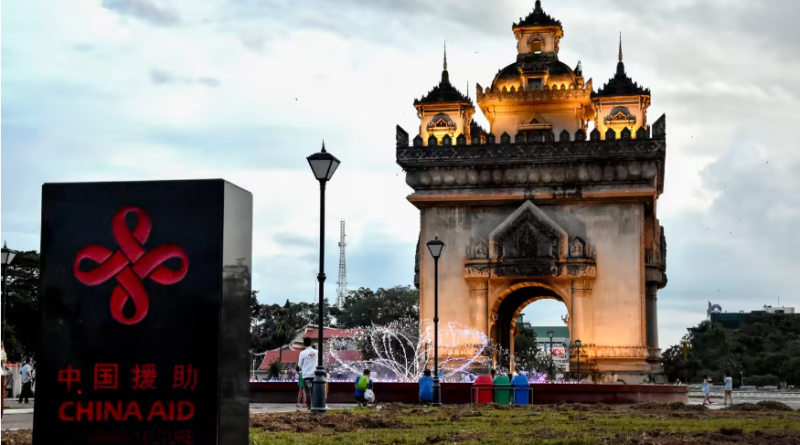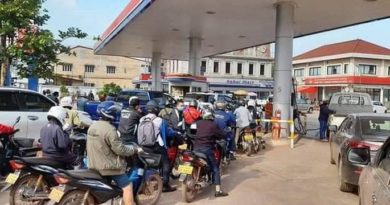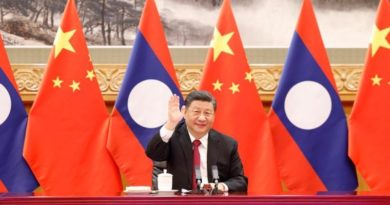Laos Debt at ‘Critical Level’ with China Payments Still Opaque
Source: Nikkei Asia
When a ChinaAid sign was recently erected in front of the Patuxai monument in Vientiane that honors those who fought for Laos’ independence from France, the imagery was grating for many in the Southeast Asian country.
“For a Shared Future” reads the red text on the black stone tablet. The undertones of the message were hard to ignore for social media users in Laos at a time when the country is enduring a long-running economic crisis, and many fear the country’s sovereignty is once again being eroded.

Laos’ public and publicly guaranteed debt stands at 123% of GDP as of 2023, according to the International Monetary Fund. More than half is owed to China, which has funded several large infrastructure projects in the country in recent years, a situation some economists have called “debt-trap diplomacy”: As Laos struggles to pay, Chinese debt deferment is conducted with no transparency, obscuring the true scale of the crisis and raising fears around Beijing’s growing sway over the country.
Mariza Cooray, a senior economist with the Indo Pacific Development Centre at the Sydney-based Lowy Institute who is currently modeling Laos’ near-term economic prospects, said she has “never seen anything like” the level of secrecy surrounding the country’s debt situation.
“Laos’ debt crisis is a lot bigger than the world realizes,” Cooray told Nikkei Asia. “That’s partly because of the incredible level of opacity, and the poor quality of the statistics and information being disseminated.”
The largest of Laos’ Chinese-funded infrastructure projects is a $5.9 billion railway inaugurated in December 2021 that connects the southern Chinese city of Kunming with the Laotian capital, Vientiane. Forming a crucial link in Beijing’s rail ambitions in Southeast Asia as part of its Belt and Road Initiative (BRI), Chinese state-owned companies hold a 70% share in the railway. The Laotian government, which holds the remaining 30%, incurred $1.9 billion in debt to have it built.
As part of efforts to become a regional exporter of electricity, Laos has also taken on huge debts over the past decade as it constructed dozens of foreign-backed dams along the Mekong River and its tributaries. But in 2021, as a debt crisis took hold, the government granted Electricite du Laos Transmission, a newly formed company with majority Chinese ownership, a 25-year concession that hands over control of large parts of Laos’ power grid to the group.
Kearrin Sims, a critical development scholar at James Cook University in Australia, said “economic mismanagement” by the government in pursuit of these projects has come at the expense of sustainable development.
“[Foreign direct investment] has been courted in hydro and natural resource extraction, as well as infrastructure expansion,” he told Nikkei Asia. “But there hasn’t been skills training, significant investments in education and health care, or job creation.”
The Laos government could not be reached for comment.
To pay for these projects, the government faces average annual public debt servicing payments of $1.2 billion a year over the next five years, according to the Asian Development Bank. With the country’s gross domestic product projected to be just $14.09 billion in 2023, the ADB’s Laos senior country economist, Emma Allen, told Nikkei that “public debt is now at a critical level,” adding that “debt servicing [presents] substantial risks to the outlook.”
Cooray said she was doubtful of Laos’ ability to carry this debt, saying the government is “digging themselves deeper into a hole.”
“I just don’t know if they’ll have the illustrious growth that they might need to get out of it,” she said. “Their strategy right now is that they’re going to grow their way out of it, but I just don’t think that’s possible.”
Cooray also cautioned that if the kip, Laos’ currency, doesn’t stabilize, “debt is going to snowball.” She added that if the country continues on its current currency depreciation trajectory, debt servicing is going to be like “pulling teeth” by 2025.
Laos’ currency has halved in value over the past two years, depreciating to record lows against the dollar in September, with almost 20,000 kip now fetching $1. This has contributed to rising prices in the import-dependent economy, with food inflation “averaging 46% between January and August,” according to the ADB’s Allen.
Major credit rating agencies have also lost faith in Laos’ ability to service its debt, downgrading the country to their highest risk categories. Most recently, in June, credit insurance group Credendo downgraded Laos’ medium- and long-term political risk rating to the highest category of 7 out of 7, citing the risk of “hidden Chinese debt.”
Payment deferments extended by China, the conditions of which remain highly opaque, have until now prevented an otherwise inevitable Lao default, as Beijing seeks to avoid another BRI participant succumbing to economic collapse after Sri Lanka. Cooray said she didn’t see a “way out for Laos, outside of debt forgiveness,” a precedent she believed Beijing is reluctant to set.
“China doesn’t want to be seen by the rest of the BRI as taking any losses,” she said. “That’s the No. 1 consideration for China, that’s why they prefer to do debt repayment discussions directly with the country.”
Looking forward, Sims said the Laotian government hasn’t offered any “convincing signs of … how to turn things around,” but emphasized that a major shift in philosophy is needed.
“We need to see a major shift in economic policy to create more employment opportunities,” he said. “More resource-extractive, jobless growth does not offer a long-term solution.”
(Photos by Alastair McCready)






